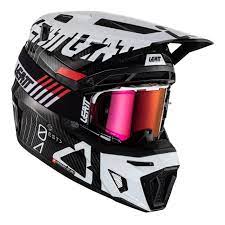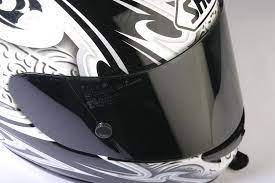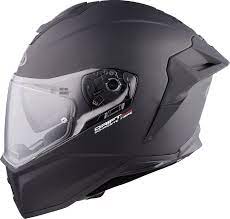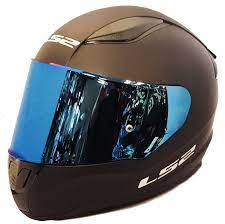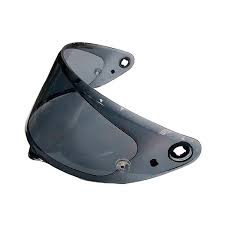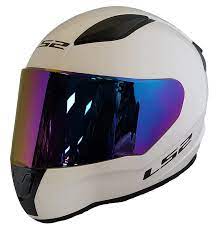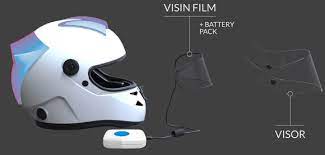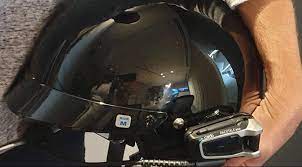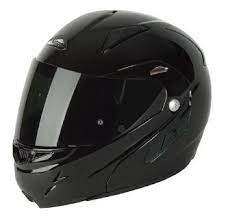
The Dual Visor Helmet: A Perfect Blend of Style and Functionality
Motorcycle riding is not just about the thrill of the open road; it’s also about safety and protection. One essential piece of gear that every rider should invest in is a high-quality helmet. Among the various options available, the dual visor helmet stands out as a perfect blend of style and functionality.
So, what exactly is a dual visor helmet? Well, as the name suggests, it is a helmet that comes equipped with two visors – one clear and one tinted. This innovative design offers riders the convenience of having both options readily available without needing to carry an extra visor or sunglasses.
One of the primary advantages of a dual visor helmet is its versatility. The clear visor provides excellent visibility during daytime rides or in low-light conditions, ensuring a clear line of sight for the rider. On the other hand, the tinted visor acts as an effective shield against harsh sunlight, reducing glare and enhancing visual comfort on bright sunny days.
The convenience factor cannot be overlooked either. With a simple flip or slide mechanism, riders can easily switch between the clear and tinted visors based on their immediate needs. This eliminates the need to carry multiple helmets or additional accessories while still providing optimal protection for varying weather conditions.
Safety is paramount when it comes to motorcycling, and dual visor helmets excel in this aspect as well. The clear visor offers unobstructed vision, allowing riders to anticipate potential hazards on the road effectively. Additionally, both visors are designed to provide adequate protection against dust, debris, insects, and even harmful UV rays.
Comfort plays a vital role in ensuring an enjoyable riding experience, and dual visor helmets deliver on this front too. Most models feature excellent ventilation systems that help regulate airflow within the helmet while preventing fogging on both visors. This feature ensures that riders maintain clarity of vision, even during long rides or in challenging weather conditions.
Style is often a consideration for riders, and dual visor helmets do not disappoint in this aspect either. Manufacturers offer a wide range of designs, colours, and finishes to suit individual preferences. Whether you prefer a sleek and minimalist look or a bold and vibrant design, there is a dual visor helmet that will match your style perfectly.
In conclusion, the dual visor helmet offers riders the best of both worlds – style and functionality. With its convenient flip or slide mechanism, versatile visor options, enhanced safety features, and optimal comfort, it is no wonder that these helmets have gained popularity among motorcyclists worldwide.
Remember, investing in a high-quality helmet is an investment in your safety on the road. So why not choose a helmet that not only provides excellent protection but also adds an extra touch of convenience and style? Consider opting for a dual visor helmet – your perfect companion for an enjoyable and safe ride every time.
Benefits of Dual Visor Helmets: Versatility, Enhanced Safety, Convenience, Comfortable Riding Experience, and Style Options
- Versatility
- Enhanced Safety
- Convenience
- Comfortable Riding Experience
- Style Options
7 Drawbacks of Dual Visor Helmets: A Comprehensive Analysis for UK Riders
- Limited customization
- Reduced airflow
- Added weight
- Potential visibility issues at night
- Maintenance and cleaning
- Cost considerations
- Availability and compatibility
Versatility
Versatility: The Key Advantage of Dual Visor Helmets
When it comes to motorcycle gear, versatility is a highly sought-after feature. And that’s precisely what makes the dual visor helmet a standout choice for riders. With its clear and tinted visors, this helmet offers unparalleled adaptability, eliminating the need for multiple helmets or additional accessories.
One of the major advantages of a dual visor helmet is its ability to cater to various weather conditions. The clear visor provides optimal visibility during daytime rides or in low-light situations, ensuring riders have a clear line of sight at all times. On brighter days, or when faced with intense sunlight, riders can effortlessly switch to the tinted visor, which effectively reduces glare and enhances visual comfort.
The convenience factor cannot be overstated either. With just a simple flip or slide mechanism, riders can easily switch between the two visors based on their immediate needs. This eliminates the hassle of carrying multiple helmets or having to invest in separate sunglasses for different weather conditions. Riders can now enjoy the convenience of having both options readily available within their helmet.
Moreover, personal preference plays a significant role in choosing a helmet. Some riders may prefer the unobstructed view provided by a clear visor, while others may find relief from harsh sunlight with a tinted one. The dual visor helmet caters to these individual preferences effortlessly, allowing riders to customize their riding experience without compromising on safety.
Safety is always paramount when it comes to motorcycling gear, and dual visor helmets excel in this aspect too. Both the clear and tinted visors are designed to offer adequate protection against dust particles, debris, insects, and harmful UV rays. This ensures that riders not only have enhanced visibility but also shield their eyes from potential hazards on the road.
In conclusion, versatility is undoubtedly one of the major advantages of dual visor helmets. The ability to switch between clear and tinted visors based on weather conditions or personal preference provides riders with unparalleled convenience. By eliminating the need for multiple helmets or additional accessories, these helmets offer a practical solution that enhances both safety and comfort on the road.
So, if you’re looking for a helmet that offers adaptability, convenience, and optimal protection, consider investing in a dual visor helmet. Experience the freedom of choice and enjoy your rides without compromise.
Enhanced Safety
Enhanced Safety: The Clear Visor Advantage
When it comes to motorcycle riding, safety should always be a top priority. One of the significant advantages of a dual visor helmet is its ability to enhance safety on the road. How does it achieve this? Through its clear visor feature.
The clear visor of a dual visor helmet provides excellent visibility, allowing riders to have an unobstructed view of the road ahead. This unimpeded line of sight is crucial for anticipating and reacting to potential hazards promptly. Whether it’s spotting a sudden obstacle or observing traffic conditions, having clear vision is essential for safe riding.
Not only does the clear visor offer excellent visibility, but it also acts as a protective shield against external elements. Dust, debris, and insects can pose significant risks while riding, potentially obstructing vision or causing distractions. The clear visor effectively blocks out these unwanted intrusions, ensuring that riders can focus on the road without any hindrances.
Furthermore, the clear visor of a dual visor helmet provides protection against harmful UV rays. Prolonged exposure to sunlight while riding can lead to eye strain and fatigue, compromising concentration and reaction times. With the clear visor acting as a barrier against UV rays, riders can enjoy enhanced comfort and reduced eye strain during their journeys.
By offering optimal visibility and protection against external elements and UV rays, the clear visor of a dual visor helmet significantly contributes to rider safety. It allows riders to stay focused on the road ahead without compromising their vision or comfort.
Remember, investing in a high-quality helmet that prioritizes safety is essential for every motorcyclist. Opting for a dual visor helmet with its enhanced safety features ensures that you can enjoy your rides with peace of mind knowing that your vision is unobstructed and protected from potential hazards.
So gear up with a dual visor helmet and experience the enhanced safety it brings to your rides. Ride confidently, knowing that you have a clear view of the road and that your eyes are shielded from dust, debris, insects, and harmful UV rays. Stay safe and enjoy the thrill of motorcycling with the added peace of mind provided by a dual visor helmet.
Convenience
Convenience: The Unmatched Advantage of Dual Visor Helmets
When it comes to motorcycle gear, convenience is key. And when it comes to helmets, the dual visor design offers an unmatched level of convenience for riders. With a simple flip or slide mechanism, switching between the clear and tinted visors is quick and easy, making dual visor helmets a game-changer in terms of practicality.
One of the primary advantages of dual visor helmets is the time and effort they save riders. Gone are the days of carrying extra visors or sunglasses to adapt to changing light conditions. With just a flick of a switch or a slide of a lever, riders can seamlessly transition from bright sunlight to low-light conditions without any hassle.
Imagine cruising down the road on a sunny day when suddenly you find yourself entering a tunnel or riding through shaded areas. Instead of squinting or struggling with sunglasses, dual visor helmet wearers can effortlessly switch from the tinted visor to the clear one, ensuring optimal visibility in an instant.
Similarly, if you’re riding during dusk or dawn when light conditions change rapidly, having both clear and tinted options readily available can make all the difference. Rather than fumbling around with multiple accessories or compromising your vision by not wearing adequate eye protection, dual visor helmets provide a seamless solution.
The convenience factor extends beyond just switching between visors. Dual visor helmets are designed with rider comfort in mind as well. Most models feature excellent ventilation systems that help regulate airflow within the helmet, preventing fogging on both visors. This ensures that riders maintain clarity of vision throughout their journey without any distractions.
Moreover, the compact and lightweight nature of dual visor helmets makes them easy to carry and store when not in use. They take up minimal space compared to carrying multiple helmets or additional accessories like separate tinted shields or sunglasses.
In conclusion, convenience is undoubtedly one of the standout advantages of dual visor helmets. The ability to switch between clear and tinted visors with a simple flip or slide mechanism saves riders valuable time and effort. No more worrying about carrying extra visors or struggling with sunglasses. Dual visor helmets offer a practical solution that enhances the overall riding experience.
So, if you’re looking for a helmet that combines functionality with unmatched convenience, consider opting for a dual visor helmet. Experience the ease of adapting to changing light conditions while enjoying the peace of mind that comes with optimal eye protection. Ride on, knowing that your helmet has got you covered in every situation.
Comfortable Riding Experience
Comfortable Riding Experience: The Dual Visor Helmet’s Ventilation System
When it comes to motorcycle riding, comfort is key. A comfortable helmet can make all the difference during long rides or in challenging weather conditions. One significant advantage of dual visor helmets is their efficient ventilation systems, which contribute to a comfortable riding experience.
Many dual visor helmets are designed with advanced ventilation systems that regulate airflow within the helmet. These systems ensure a constant circulation of fresh air, preventing the buildup of heat and moisture inside the helmet. As a result, riders can enjoy a cool and comfortable ride even during hot weather or intense physical activity.
One common problem faced by riders is fogging on the visors due to temperature differences between the inside and outside of the helmet. However, dual visor helmets address this issue effectively. The ventilation system works in tandem with anti-fog properties on both visors, reducing the chances of fogging significantly. This means that riders can maintain clear visibility without any hindrance caused by fogged-up visors.
The efficient ventilation system also plays a crucial role in preventing discomfort caused by excessive sweating. By allowing air to circulate freely, moisture is wicked away from the rider’s head, keeping them dry and comfortable throughout their journey. This feature is especially beneficial for those who embark on long rides or engage in physically demanding activities while wearing their helmets.
Moreover, proper airflow helps combat odours that may develop inside the helmet over time. By continuously circulating fresh air, unpleasant smells are minimized, ensuring a more pleasant riding experience for both the rider and those around them.
Whether you’re cruising along scenic routes or navigating through congested city streets, a dual visor helmet with an efficient ventilation system can make your ride much more enjoyable. No more discomfort from excessive heat or fogged-up visors obstructing your vision.
So, if you value comfort during your rides and want to ensure optimal airflow and visibility regardless of the weather, consider investing in a dual visor helmet with an advanced ventilation system. Your comfort and safety on the road should always be a top priority, and with this innovative feature, you can experience a truly comfortable riding experience every time you hit the road.
Style Options
Style Options: Elevate Your Look with a Dual Visor Helmet
When it comes to motorcycle gear, style is an essential consideration for riders. After all, your helmet is not just a piece of protective equipment; it’s also a reflection of your personal taste and individuality. That’s where the dual visor helmet shines, offering an extensive range of design options to suit every rider’s preferences and styles.
One of the standout advantages of dual visor helmets is the vast array of style options available. Whether you lean towards a classic and timeless look or prefer something more modern and vibrant, there is undoubtedly a dual visor helmet that will match your aesthetic perfectly.
For those who appreciate simplicity and elegance, there are sleek and minimalist designs available. These helmets boast clean lines and understated finishes, exuding a sense of sophistication while still providing excellent protection on the road.
On the other hand, if you prefer to make a bold statement with your gear, there are dual visor helmets that feature eye-catching graphics and vibrant colours. These helmets allow you to express your personality through dynamic patterns or striking designs that are sure to turn heads wherever you ride.
Furthermore, manufacturers understand that individual preferences vary greatly when it comes to helmet finishes. That’s why dual visor helmets come in a range of finishes such as gloss, matte, or even metallic. This variety ensures that riders can find a helmet that not only complements their style but also adds an extra touch of uniqueness to their overall look.
The availability of different sizes further enhances the style options offered by dual visor helmets. Whether you have a smaller or larger head size, there are models designed to provide both comfort and style for riders across the spectrum.
It’s important to remember that while style is an important aspect when choosing a helmet, safety should always remain paramount. Dual visor helmets not only offer an extensive range of design options but also meet rigorous safety standards to ensure optimal protection on the road.
So, if you’re looking to elevate your look while prioritizing safety, consider a dual visor helmet. With its wide range of designs, colours, and finishes, you can find the perfect helmet that not only matches your style but also provides the necessary protection for your motorcycle adventures.
Remember, riding in style doesn’t mean compromising on safety. Choose a dual visor helmet that not only reflects your personality but also ensures that you ride with confidence and peace of mind. Embrace the fusion of style and functionality with a dual visor helmet and make a statement wherever the road takes you.
Limited customization
A Consideration for Dual Visor Helmets: Limited Customization Options
When it comes to choosing the perfect motorcycle helmet, customization is often a factor that riders consider. While dual visor helmets offer a range of benefits, one potential downside to keep in mind is their limited options for customization.
Unlike some other helmet types on the market, dual visor helmets feature an integrated design that includes both a clear and tinted visor. This design choice can limit the ability to personalize the helmet with additional accessories or modifications.
For riders who enjoy adding their own personal touch to their gear, such as attaching stickers, decals, or other accessories, the integrated nature of dual visor helmets may pose a challenge. The presence of two visors can restrict the available space on the helmet’s exterior surface, leaving less room for customization.
Furthermore, some riders may prefer to modify their helmets by adding features like Bluetooth communication systems or action camera mounts. While these additions are often possible with other helmet types, they may be more challenging to implement on a dual visor helmet due to its specific design.
It’s important to note that limited customization options do not diminish the safety and functionality of dual visor helmets. They still provide excellent protection, visibility options, and comfort features that make them popular among motorcyclists. However, if personalized aesthetics or additional modifications are high on your priority list when selecting a helmet, it’s worth considering alternative options that offer more flexibility in terms of customization.
Ultimately, the decision about whether limited customization is a significant concern will depend on individual preferences and priorities. Riders who prioritize convenience and functionality may find that the benefits of a dual visor helmet outweigh any limitations in customization options.
Before making a purchase decision, it’s always advisable to carefully assess your needs and preferences as a rider. Consider factors such as safety features, comfort, visibility options, and yes – even customization possibilities – to ensure you select a helmet that aligns with your specific requirements and enhances your overall riding experience.
Reduced airflow
Reduced airflow: A Consideration for Dual Visor Helmets
While dual visor helmets offer numerous benefits, it is important to consider potential drawbacks as well. One aspect that riders should be aware of is the potential reduction in airflow within the helmet.
The presence of two visors in a dual visor helmet can sometimes impede the natural flow of air within the helmet. This can result in reduced ventilation, especially during rides in hot and humid conditions. Insufficient airflow may lead to discomfort, as it can cause excessive sweating and a feeling of stuffiness inside the helmet.
Additionally, reduced airflow can contribute to fogging issues on both visors. Fogging occurs when warm, moist air from the rider’s breath comes into contact with the cooler surface of the visor. Inadequate ventilation exacerbates this problem, making it more challenging to maintain clear visibility while riding.
To mitigate these concerns, many dual visor helmets are equipped with advanced ventilation systems. These systems are designed to promote better airflow by strategically placing intake and exhaust vents throughout the helmet. They help channel fresh air into the helmet while simultaneously expelling warm air, reducing the likelihood of discomfort and fogging.
It is crucial for riders to choose a dual visor helmet that prioritizes ventilation without compromising safety features. When selecting a helmet, consider models that have well-designed ventilation systems with adjustable vents that allow you to regulate airflow according to your preferences and prevailing weather conditions.
Regular maintenance is also essential for optimal performance. Keep your dual visor helmet clean and free from debris that may obstruct ventilation ports or compromise visibility. Additionally, anti-fog coatings or inserts can be applied to mitigate fogging issues on the inner surface of both visors.
In conclusion, while reduced airflow is a potential drawback of dual visor helmets, it should not discourage riders from considering them as an option. By selecting a well-ventilated model and practicing proper maintenance techniques, riders can minimize any discomfort or fogging issues associated with reduced airflow. It is crucial to strike a balance between the convenience and functionality of dual visor helmets while ensuring optimal comfort and safety during rides.
Added weight
Added Weight: A Consideration for Dual Visor Helmets
When it comes to choosing the perfect helmet, riders often consider various factors such as safety, comfort, and style. While dual visor helmets offer many advantages, it’s important to acknowledge one potential drawback: added weight.
Dual visor helmets tend to be slightly heavier compared to their single-visor counterparts. This is primarily due to the additional hardware required for the double-visor system. While the weight difference may not be significant, it can become noticeable over longer rides or extended periods of wear.
The added weight of a dual visor helmet can potentially lead to fatigue for some riders. The neck and shoulder muscles may have to work harder to support the extra load, especially during extended journeys. This fatigue can impact overall comfort levels and potentially affect concentration on the road.
However, it’s important to note that the weight difference between dual visor helmets and single-visor models is generally minimal. Manufacturers continuously strive to reduce the weight of their helmets through innovative design techniques and lightweight materials. Additionally, advancements in technology have led to dual visor helmets becoming more streamlined and ergonomic, minimizing any discomfort caused by added weight.
Ultimately, the impact of added weight will vary from rider to rider. Some individuals may not notice a significant difference or experience any discomfort at all. Others might find it more noticeable during longer rides or if they have specific neck or shoulder conditions.
If you are concerned about the potential impact of added weight on your riding experience, it’s advisable to try on different models and brands before making a purchase. This will allow you to assess how comfortable each helmet feels on your head and determine if any extra weight affects your overall comfort levels.
In conclusion, while dual visor helmets offer numerous benefits such as versatility and enhanced safety features, it’s essential to consider all aspects before making a decision. Added weight is one consideration that may affect comfort levels for some riders, particularly during longer journeys. However, it’s important to remember that advancements in design and materials are continuously improving helmet technology, minimizing the impact of added weight.
Ultimately, finding the right balance between safety, functionality, and comfort is key when choosing a helmet. By considering all factors, including added weight, riders can make an informed decision that best suits their individual needs and preferences.
Potential visibility issues at night
Potential visibility issues at night: While clear visors provide excellent visibility during daytime rides, they may not be ideal for riding at night or in low-light conditions. The tinted inner sun shield could limit vision and make it more challenging to see clearly in darker environments.
When it comes to motorcycle safety, visibility is of utmost importance. Riding at night already poses challenges due to reduced lighting conditions, and the presence of a tinted inner sun shield in a dual visor helmet can exacerbate these difficulties. The tinted shield, designed to protect against bright sunlight during the day, may hinder the rider’s ability to see clearly when natural light is limited.
In darker environments, such as poorly lit roads or rural areas with minimal street lighting, relying solely on the clear visor may be necessary for optimal visibility. However, switching between visors while riding can be inconvenient and time-consuming. Additionally, removing or adjusting the tinted visor at night may not always be possible or practical.
It is important for riders to consider their specific riding conditions and preferences when choosing a helmet. If you frequently ride at night or in low-light situations, a dual visor helmet may not be the most suitable option. Instead, helmets with single clear visors or those specifically designed for nighttime riding might offer better visibility and safety.
To ensure maximum safety on the road, riders should prioritize their ability to see clearly in all lighting conditions. If you find yourself frequently riding at night or in low-light environments, it may be worth considering alternative helmet options that prioritize enhanced visibility during these times.
Remember that your safety should always come first when choosing motorcycle gear. While dual visor helmets offer convenience and versatility during daytime rides, it’s crucial to weigh the potential limitations they may present under certain lighting conditions. Ultimately, selecting a helmet that provides optimal visibility in all situations will help ensure a safer riding experience overall.
Maintenance and cleaning
Maintenance and Cleaning: A Consideration for Dual Visor Helmets
When it comes to the convenience and versatility of a dual visor helmet, there is no denying its benefits. However, like any piece of equipment, it is important to consider all aspects before making a decision. One potential drawback to keep in mind is the maintenance and cleaning involved with these helmets.
Unlike single-visor models, dual visor helmets require a bit more attention when it comes to keeping them clean and well-maintained. The presence of two separate visors means that each surface needs to be cleaned individually, which can be slightly more complicated.
Care must be taken when cleaning the visors to avoid damaging any components. Using harsh chemicals or abrasive materials can scratch or weaken the surfaces, compromising their clarity and durability. It is crucial to follow the manufacturer’s instructions regarding cleaning products and methods to ensure proper care.
Additionally, due to the intricate design of dual visor helmets, there may be more areas where dirt, dust, or moisture can accumulate. This means that riders need to pay extra attention when cleaning these helmets thoroughly. Regular maintenance is essential not only for hygiene purposes but also for ensuring optimal functionality.
To simplify the cleaning process and minimize potential damage, it is recommended to use gentle cleaning solutions specifically designed for helmet visors. Microfiber cloths or soft brushes can be used to remove any debris without scratching the surfaces. Taking a few extra minutes for proper maintenance can go a long way in preserving the lifespan of your dual visor helmet.
While maintenance and cleaning may require some additional effort compared to single-visor models, it is important not to overlook their overall benefits. Dual visor helmets offer riders unparalleled convenience and protection on the road. The ability to switch between clear and tinted visors without carrying extra accessories adds significant value during varying weather conditions.
In conclusion, while maintenance and cleaning may pose a slight challenge with dual visor helmets, it should not overshadow the advantages they offer. By following proper cleaning procedures and investing a little extra time and care, riders can ensure their dual visor helmet remains in top-notch condition for years to come.
Remember, a well-maintained helmet is an essential component of rider safety. So, if you’re considering a dual visor helmet for its convenience and versatility, just keep in mind the importance of proper maintenance and cleaning. With the right approach, you can enjoy all the benefits these helmets have to offer while keeping them in excellent shape.
Cost considerations
Cost Considerations: Exploring the Con of Dual Visor Helmets
When it comes to choosing the right helmet, riders have a plethora of options available. One popular choice is the dual visor helmet, which offers the convenience of both clear and tinted visors in one design. However, like any product, dual visor helmets have their drawbacks, and one significant con is the cost.
Compared to basic single-visor helmets, dual visor models often come with a higher price tag. This is primarily due to the added functionality and features they offer. The inclusion of two visors, along with mechanisms for easy switching between them, requires more complex engineering and manufacturing processes, which can drive up production costs.
For riders on a tight budget or those who prioritize cost-effectiveness, this higher price point can be a factor that needs careful consideration. It’s important to assess your specific needs and budget constraints before making a decision.
However, it’s worth noting that while dual visor helmets may initially seem more expensive compared to their single-visor counterparts, they do provide added value in terms of convenience and versatility. With the ability to switch between clear and tinted visors effortlessly, riders can adapt to different lighting conditions without needing to carry extra accessories or invest in separate helmets.
Moreover, dual visor helmets often come equipped with advanced features such as improved ventilation systems and anti-fog coatings on both visors. These additional benefits contribute to overall comfort and safety during rides.
To make an informed decision about whether a dual visor helmet is worth the investment for you personally, consider factors such as your riding habits, typical weather conditions in your area, and how frequently you may need to switch between clear and tinted visors. If these aspects align with your requirements and preferences, then the added cost might be justified by the enhanced functionality offered by dual visor helmets.
Ultimately, when considering any motorcycle gear purchase, it’s crucial to strike a balance between quality, functionality, and affordability. Dual visor helmets may come at a higher price point, but they also offer the convenience of having two visors readily available in one helmet. By carefully evaluating your needs and budget, you can determine if the benefits outweigh the cost and make an informed decision that suits your riding style and preferences.
Availability and compatibility
Availability and Compatibility: Factors to Consider with Dual Visor Helmets
When it comes to choosing the perfect helmet for your motorcycle adventures, dual visor helmets offer a range of benefits. However, it’s important to consider certain drawbacks as well. One such con is the availability and compatibility of these helmets.
Not all helmet brands or models offer dual visor options, which means there might be limited availability depending on your preferences or specific requirements such as size or style choices. While many popular brands do offer dual visor helmets, it’s essential to research and find the ones that meet your needs.
Compatibility is another aspect to consider. If you already own a helmet and wish to upgrade it with a dual visor system, not all helmets are designed to accommodate this feature. It’s crucial to check if your current helmet has the necessary mechanisms and space for installing a dual visor system.
Additionally, even if a particular helmet brand offers dual visor options, not all models within that brand may have this feature. Each model may have its own unique specifications and features, so it’s important to carefully review the product details before making a purchase.
Size compatibility is also worth considering. While most brands offer a range of sizes for their helmets, not every size option may come with the dual visor feature. This means that if you have specific sizing requirements, you might need to compromise on having a dual visor option or explore other brands that provide suitable sizing with this feature.
Lastly, style choices can be limited when it comes to dual visor helmets. Not all designs or finishes may be available in models that offer this feature. If you have a particular aesthetic preference in mind, finding a helmet that matches both your style and has the dual visor functionality might require some additional searching.
In conclusion, while dual visor helmets have their advantages in terms of convenience and functionality, availability and compatibility can pose limitations depending on your preferences and requirements. It’s important to research and explore different brands, models, and sizes to find the dual visor helmet that best suits your needs while offering the desired features and style options you seek.
